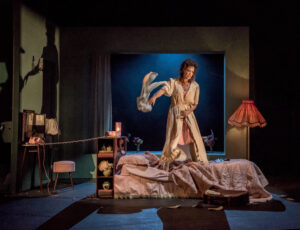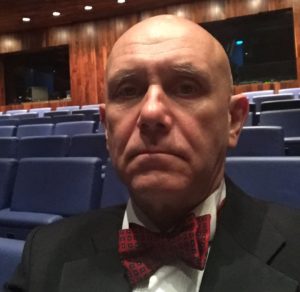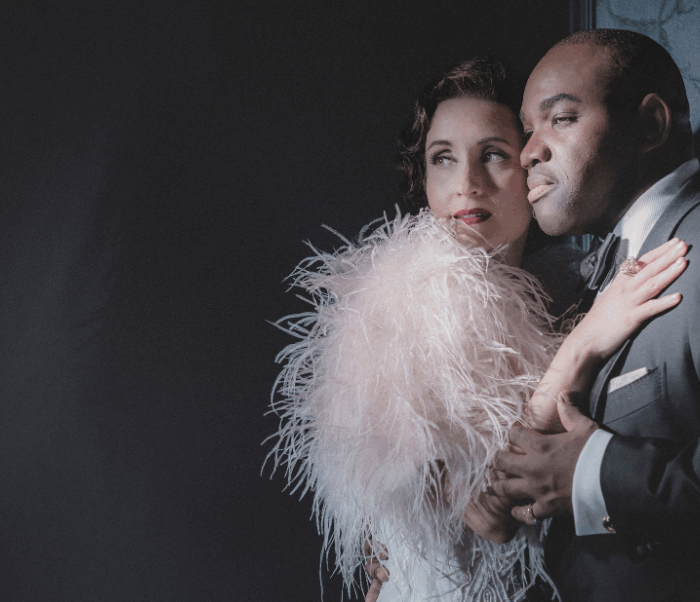
Buxton International Festival 2025 Review: ‘Trouble In Tahiti’ & ‘La Voix Humaine’
Director Daisy Evans’ Imaginative Presentations Make A Convincing Pairing
By Alan Neilson(Photo:Genevieve Girling)
There really does need to be a connection between the operas chosen by a company if it decides to stage a double bill. Two randomly chosen pieces with little to tie the works together, or worse, drawing attention to certain common superficialities and presenting them as an artistically founded pairing, is not simply lazy programming but is also a missed opportunity to explore connections. The Buxton International Festival’s decision to stage Bernstein’s “Trouble in Tahiti” alongside Poulenc’s “La Voix Humaine” certainly caught the attention; what are the connections between these works, and how do they support each other when performed together?
Interestingly, in his program notes, David Webber identified 20th century technology and its effects on people as the theme underpinning both works but presented from two very different perspectives. In “La Voix Humaine,” the telephone is central; the nature of the relationship between Elle and her lover is significantly determined by the ability to communicate over distance, almost at will, but with the potential for further possibilities of anxiety, deception and intrusion. “Trouble in Tahiti,” on the other hand, looks at the effects of technology in its wider forms, such as cinema, telephone and labour-saving devices, on the difficulties facing people searching for a sense of peace and fulfillment in the modern world.
Daisy Evans’ Layered Readings Brings the Best from Both Works
The director, Daisy Evans, while not ignoring this aspect at all, took a feminist stance, highlighting specifically the role of the woman and their suffering at the hands of men in both works, and in doing so unites them in a common theme. Normally, in “La Voix Humaine,” it is only the woman, Elle, that is present on stage, but in this production her lover and his new girlfriend are also present. While she is descending into further despair, we watch the man and his new lover enjoying their relationship in a room at the edge of the stage. Evans also brilliantly brought home the cold reality of the situation by having Elle’s lover’s new partner cut her off while she is on the phone.
In “Trouble in Tahiti” the focus is always on Dinah’s misery, while Sam does his best to ignore both her and his own problems, which he constantly attempts to sidestep. They may both be suffering in their own ways from the lie that underpins the American Dream of consumer heaven and domestic bliss, but Evans’ portrayal of Sam as a more selfish and brutal character ensures the blame also falls upon his shoulders; as with the male protagonist in “La Voix Humaine,” Sam has found another woman with whom he is having an affair, which we were able to view in the other room at the side of the set.
The interweaving of the effects of technology on people’s lives with the proclivities and roles played by men and their effects on women brought the two works together and allowed the themes to be explored from different standpoints. Evans brought a further degree of integration by having the trio from “Trouble in Tahiti,” whose role was to bring a sunny optimism to everything about the new America, reappear in “La Voix Humaine” as imaginary figures who move gently in and out of her space towards the end of the opera and finally guide Elle into committing suicide by tucking her up in bed and giving her pills.
Evans, aided by scenic and costume designer Loren Elstein, was also successful in presenting the narrative of both works in a clear and engaging fashion, using a basic common set, although with different props.
For “Trouble in Tahiti,” the middle of the stage was taken up by a table and chairs around which Sam and Dinah squabbled and ignored each other, behind which was a raised area that acted as Sam’s office at work. To the left was a small corridor, and to the far left another room in a different building, where Sam met with his girlfriend. The stage was saturated in a green-colored light.
For “La Voix Humaine,” the central area was transformed into a bedroom scene, reminiscent of Tracey Emin’s famous bed, around and upon which most of the drama took place. To the immediate left, the corridor became a small bathroom, in which Elle vomited after overdosing on drugs while her lover was trying to call her on the telephone. To the extreme left, the other room in a different building allowed us a glimpse into her lover’s behavior.
Iwan Davies Oversees a Successful Musical Performance
The central protagonists of “Trouble in Tahiti,” Sam and Dinah, were brought expertly alive by baritone Charles Rice and mezzo-soprano Hanna Hipp. Even if they leaned heavily upon stereotypical ideas of the post-war American family, they both managed to create convincing, detailed portraits of their characters, to the extent that it was easy for the audience to empathize with the underlying sense of disappointment and frustrations that defined their existence.
Rice produced a strong performance, in which his clearly articulated singing captured Sam’s various emotional states. In the home, he sounded bored and tired, while at work his singing was bright, forceful and dynamic; he was a man to be reckoned with as he accepted and rejected loan applications! In his aria “There is a law about men,” he gives voice to his delusion about being one of life’s winners, just because he won a handball tournament, in which his voice rang out triumphantly.
His wife Dinah was given a compelling rendition by Hipp, who captured her dissatisfaction with life and her seeming inability to do anything about it; she just went through the motions, watching films like “Trouble in Tahiti,” which added to her sense of frustration, and relying on a psychiatrist to help fix her emotional state. Her singing was sensitively rendered, in which she successfully colored and accented the voice to convey her overwhelming sense of dissatisfaction.
The trio played by soprano Chloé Hare-Jones, tenor Harun Tekin and baritone Ross Cumming offset the dispiriting state of gloom, broken only by the superficial spikes of pleasure, that hung over Sam and Dinah’s relationship with a vibrant, optimistic depiction of life in numbers such as “Mornin’ Sun” and “Skid a little,” in which their voices positively shone.
Conductor Iwan Davies conducting the Buxton International Festival Orchestra elicited an energetic reading with a clean, bright, and detailed sound with a strong dramatic momentum and successfully captured the fusion of classical, broadway and jazz elements that define the instantly recognizable Bernstein sound.
Allison Cook’s Standout Performance as Elle
It is not unusual to be entranced by the musical drama that unfolds in performances of “La Voix Humaine,” but visually it can often lack the necessary movement and interest to keep the audience sharply focused. That was certainly not the case here. Not only did Evans introduce other characters that included a telephone engineer at the beginning of the opera to fix the problem with the line, but she also had the soprano Allison Cook constantly on the move: if she was not wandering around her bedroom, phone in hand, she was lying or sitting on the bed, taking pills or vomiting in the toilet. In the final section, she interacted with three figures, manifested from her imagination, who took on the responsibility for her suicide.
Cook created a compelling picture of Elle; her passion, pain and anxieties were etched into her voice and onto her face. With every phone call, her emotions became more unstable, reflecting her rising desperation, before an exhausted acceptance took over. Her vocal control and versatility ensured her singing was clear, articulate and detailed, and her phrasing was sensitively moulded to fit the emotional contours of the line. She moved easily into her upper register, in which her piercing voice could leave no one in doubt as to the anguish and pain that was overwhelming her. It was a dominant performance that was not at all compromised by having other characters on stage.
Davies produced another fine performance with a dramatically sensitive reading from the Buxton International Festival Orchestra, in which the textural qualities of the score were beautifully revealed. The clarity and cleanliness of the sound that he was once again able to obtain from the orchestra impressed.
Overall, the choice of “Trouble in Tahiti” and “La Voix Humaine” proved to be an inspired pairing; they were two very different works that took very different approaches, yet Evans’ imaginative direction and clever staging uncovered connections that in hindsight seemed so obvious.
Musically, it was an excellent production.



